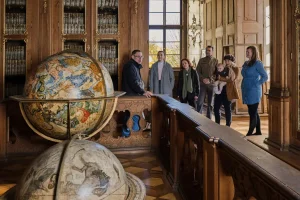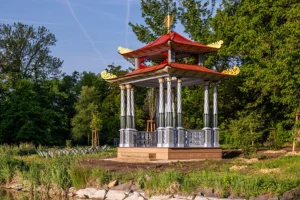The Archbishop’s Palace – a Baroque Jewel of Moravia – Continues to Impress with New Attractions for Visitors
Let’s take a look at the latest highlights this year from one of the region’s most important heritage sites, together with the adjoining Chateau Garden.
Via Magnifica
The name of the new visitor route on the second floor of the palace can be freely translated as “The Magnificent Way.” It focuses on the palace’s art and collector’s treasures, offering a truly remarkable experience. Visitors can now choose between a guided tour or a self-guided tour using an audioguide, available in Czech, English, German, and Polish.
The tour showcases unique collections, including the Old and New Libraries, the Coin Cabinet, the Music Cabinet, the Garden Culture Room, the Manský Hall, the Chapel of St. Sebastian, and of course the famous Picture Gallery, internationally known for works by Titian, van Dyck, and Cranach.
Josef Mánes Returns to Moravia
From 23 May to 31 August, the Gallery Corridor on the 2nd floor of the palace hosts an exhibition dedicated to the renowned Czech painter Josef Mánes. Titled Josef Mánes Returns to Moravia, the exhibition explores the artist’s deep connection to the Moravian region. Curated by Markéta Vondrová and Veronika Hulíková, the exhibition presents drawings of folk costumes, graphic works, and paintings – including the famous Red Parasol, inspired by Mánes’ visits to Čechy pod Kosířem and currently on long-term loan to the National Gallery in Prague from a private collection.
Mánes visited Moravia repeatedly and, thanks to strong personal and artistic ties, considered it his “second home.”
The Chinese Pavilion
Several new highlights await in the Chateau Garden as well. One of them is the Chinese Pavilion, which underwent extensive restoration at the end of last year. It now shines in the form it had between 1900–1910, with three wooden pillars at each corner richly decorated with dragon reliefs, a two-tier metal roof, and a decorative weathervane shaped like a Chinese dragon. The bright colours and ornamental elements give the pavilion a fairy-tale character.
Inside, the space is furnished with a small wooden table and decorative objects, including exotic plants. The Chinese Pavilion stands on an island in the Wild Pond, where the Beam Pavilion has also been restored. Another notable feature is the group of five small buildings on the island in the Long Pond, known as the Turkish Tents – originally intended, most likely, as shelters for waterfowl.
TIP:
Enhance your stroll through the Chateau Garden with the SmartGuide mobile app, which turns your phone into a personal audio guide. Thanks to GPS, audio narration plays automatically as you approach points of interest – offering insights into the garden’s history, architecture, and layout.


